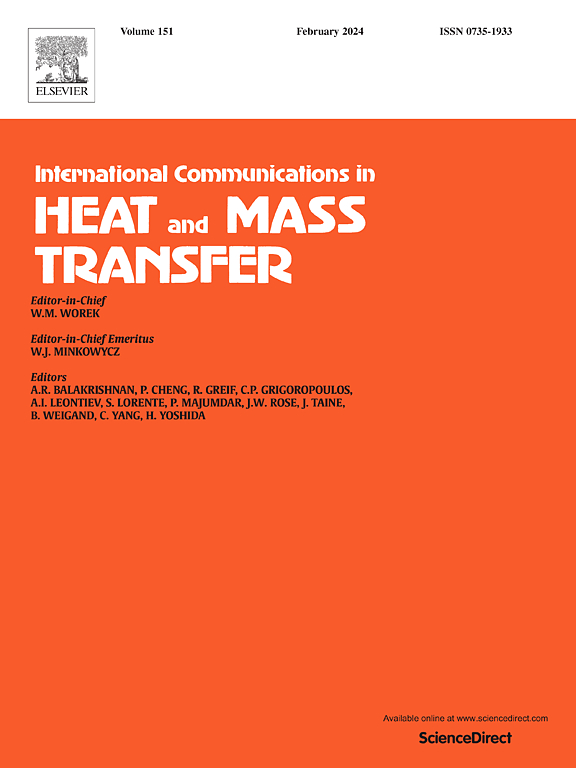引入表面活性剂的纳米通道中热渗透流动方向反转可调
IF 6.4
2区 工程技术
Q1 MECHANICS
International Communications in Heat and Mass Transfer
Pub Date : 2025-06-27
DOI:10.1016/j.icheatmasstransfer.2025.109288
引用次数: 0
摘要
热渗透是纳米通道中由热梯度引起的流体流动现象。一般来说,逆转热渗透的方向需要进行结构修改,这限制了实际应用。本文提出了一种基于表面活性剂的方法,在不改变纳米通道的情况下逆转热渗透的方向。分子动力学模拟表明,纳米通道内热渗透流动的方向和强度可以通过改变表面活性剂的浓度来调节。表面活性剂的引入显著地改变了界面自由能的分布。通过计算平均力势,发现表面活性剂的加入使流动方向由正(高-低温)向负(低-高温)转变,这是由于平均力分布势沿流动方向的斜率发生了符号变化。数值研究进一步量化了通道宽度、表面活性剂亲水性和体系温度对临界反转浓度的影响。这项工作提出了一种可调的、与结构无关的方法来逆转热渗透的方向,从而推进了自适应纳米流体和节能热管理的应用。本文章由计算机程序翻译,如有差异,请以英文原文为准。
Tunable direction reverses of thermo-osmotic flow in a nanochannel by introducing surfactant
Thermo-osmosis is a fluid flow phenomenon in a nanochannel caused by thermal gradients. Generally, reversing the direction of thermo-osmosis requires structural modifications, which limit practical applications. This paper proposes a surfactant-based method to reverse the direction of thermo-osmosis without altering the nanochannel. Molecular dynamics simulations demonstrate that the direction and strength of thermo-osmotic flow in nanochannels can be tuned by varying the surfactant concentration. The introduction of surfactants into the fluid significantly alters the distribution of interfacial free energy. By calculating the potential of mean force, it is found that the addition of the surfactant can reverse the flow direction from positive (high-to-low temperature) to negative (low-to-high temperature), which is attributed to the sign change in the slope of the potential of mean force distribution along the flow direction. Numerical studies further quantify the influence of channel width, surfactant hydrophilicity, and system temperature on the critical reversal concentration. This work presents a tunable, structure-independent method for reversing the direction of thermo-osmosis, thereby advancing applications in adaptive nanofluidics and energy-efficient thermal management.
求助全文
通过发布文献求助,成功后即可免费获取论文全文。
去求助
来源期刊
CiteScore
11.00
自引率
10.00%
发文量
648
审稿时长
32 days
期刊介绍:
International Communications in Heat and Mass Transfer serves as a world forum for the rapid dissemination of new ideas, new measurement techniques, preliminary findings of ongoing investigations, discussions, and criticisms in the field of heat and mass transfer. Two types of manuscript will be considered for publication: communications (short reports of new work or discussions of work which has already been published) and summaries (abstracts of reports, theses or manuscripts which are too long for publication in full). Together with its companion publication, International Journal of Heat and Mass Transfer, with which it shares the same Board of Editors, this journal is read by research workers and engineers throughout the world.

 求助内容:
求助内容: 应助结果提醒方式:
应助结果提醒方式:


